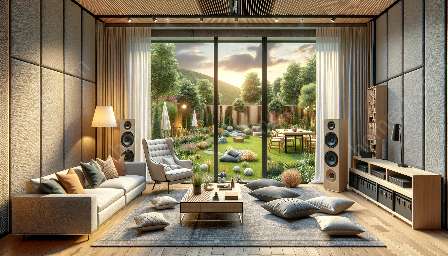Noise control is a crucial aspect of architecture, impacting both indoor and outdoor environments. When creating interior spaces, the impact of room acoustics on indoor noise levels must be carefully considered. Additionally, noise control in homes plays a significant role in creating comfortable living environments. This article will explore the architectural considerations for noise control and its impact on both indoor and outdoor settings.
Importance of Noise Control in Architecture
Architectural design has a direct influence on the acoustics and noise levels within a space. Proper noise control not only contributes to a more pleasant environment for occupants but also impacts the overall functionality and well-being of individuals. From public buildings and offices to residential homes, architectural considerations for noise control are essential for enhancing comfort and productivity while reducing stress and potential health issues associated with excessive noise exposure.
Designing Spaces for Optimal Acoustics
Architects and designers utilize various strategies to address noise control within the built environment. This includes the careful selection of building materials, layout configurations, and acoustic treatments. Sound-absorbing materials, such as acoustic ceiling tiles and wall panels, play a significant role in minimizing reverberation and controlling noise levels within a space. Additionally, the strategic placement of acoustic barriers and partitions can help create zones of tranquility while minimizing the transmission of unwanted noise.
Impact of Room Acoustics on Indoor Noise Levels
Room acoustics directly influence the propagation and perception of noise within indoor environments. Factors such as the dimensions of a room, surface materials, and the presence of reflective surfaces can significantly impact the overall acoustics and noise levels within a space. Proper consideration of these factors during the architectural design phase is critical for creating interior spaces with balanced acoustics and reduced noise pollution.
Implementing Sound Isolation Techniques
Architects and construction professionals also employ sound isolation techniques to minimize the transmission of noise between different areas within a building. This involves the use of resilient channels, double-stud walls, and soundproofing insulation to control airborne and impact noise. By implementing these techniques, the overall indoor noise levels can be effectively managed, creating more peaceful and functional environments for occupants.
Noise Control in Homes
When it comes to residential settings, noise control is a critical consideration for creating comfortable and serene living spaces. From minimizing external noise sources, such as traffic and neighborhood activities, to reducing the transmission of noise between rooms and floors, architectural design plays a pivotal role in enhancing the acoustic quality of homes. Additionally, the incorporation of sound-absorbing elements and thoughtful spatial planning can further contribute to a quieter and more enjoyable living experience.
Integrated Design Approach
Effective noise control in homes requires an integrated design approach that encompasses architectural, structural, and mechanical systems. This holistic approach allows for the seamless integration of noise control measures within the overall design process, resulting in homes that offer improved acoustic comfort and reduced exposure to unwanted noise. By considering factors such as building orientation, window placement, and the selection of building materials, architects can create homes that prioritize noise control without compromising on aesthetic appeal and functionality.
Conclusion
Architectural considerations for noise control are integral to creating environments that promote well-being and productivity. From the impact of room acoustics on indoor noise levels to the specific measures implemented in homes, the role of architecture in controlling noise cannot be overstated. By embracing sound design practices and incorporating effective noise control strategies, architects can elevate the quality of indoor and outdoor spaces, ultimately enhancing the overall human experience.


